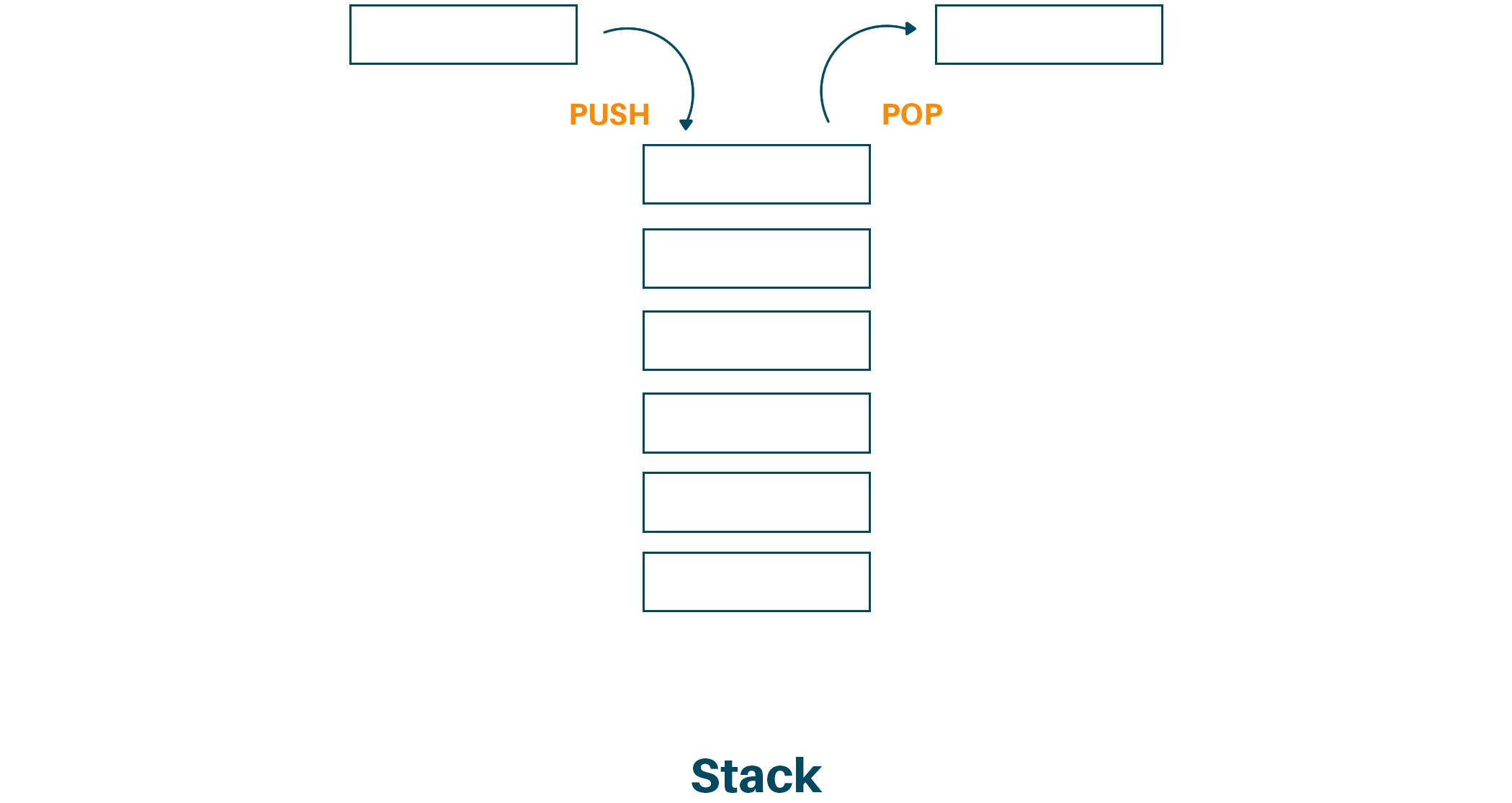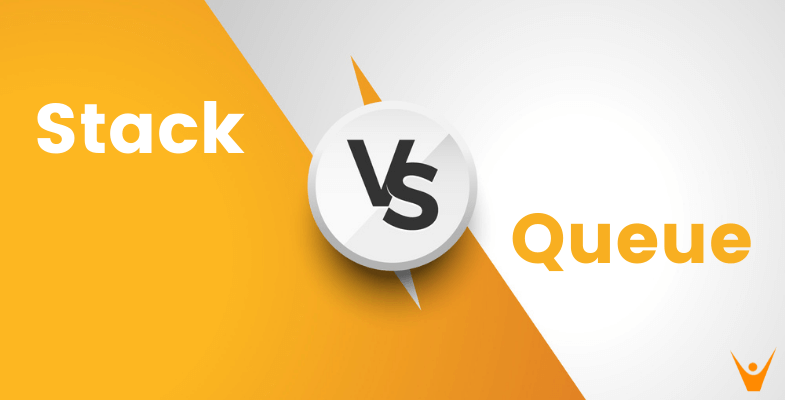Stack & Queue are two very important data structures in the programming world. In this article, we will study all the main differences between Stack and Queue. Then, we will know the practical applications of both of them. But before all this, we first revise the basics. So, let's get started!
What is Stack?
Stack is a linear data structure that follows the specific order to perform the operations. For example, if we want to access the element in the array we can do it at any time but in the case of stack data structure, there is only one sequence to access the element.
In the stack, we insert the element from one end with the push operation and delete the element from the same end using the pop operation. The end of the stack used to perform all the operations is called the top of the stack. Therefore, a stack follows the LIFO (Last In First Out) principle, which means the element that is inserted last will be the first element to come out of the stack.

What is a real-life example of a Stack?
A stack of dishes serves as a practical illustration of a stack. A plate is added to the stack by piling it on top of the previous ones. You take the top plate out of the stack first when taking a plate out of the stack.
A stack of books is another instance of a stack in real life. You add books to the stack by stacking them on top of one another. The top book is taken out of the stack first when you take one out. This functions in a manner akin to a stack in computer programming.
A call stack is a specific kind of stack that is employed in computer programming to keep track of function calls. A function is added to the call stack whenever it is called. The function is taken off the call stack when it completes and returns. As a result, the programme is able to trace which function is currently active alongside the function called it.
What is Queue?
The Queue is a linear data structure in which we can insert the element from one side of the list and delete the element from the other side of the list. The end of the list from where the elements are inserted is called the rear end and the end from where the elements are deleted is called the front end.
Therefore, the queue data structure follows the FIFO(First In First Out) principle, which means the element inserted first from the rear end will be the first element to be deleted from the front end. The insertion technique in the queue data structure is called enqueue operation and the deletion technique in the queue data structure is called dequeue operation.
While performing operations in the queue, there are two pointers, the front pointer and the rear pointer, where the front pointer is used to point to the element that is added first in the queue and the rear pointer is used to point to the element which is added last in the queue.

What is a real-life example of a Queue?
Our first example will be of a Printer backlog. A queue is created when many papers are sent to a printer. The first document that is added to the queue will be printed first, and so on. This guarantees that the printed documents appear in the order that they were sent.
Another real-world instance is of a Grocery store checkout queue. A queue in operation can be seen clearly in the checkout queue at the grocery store. Customers are served and lined up in the same order that they arrived. The first person in line will be served, and the last person in line will be served last.
Difference between Stack and Queue
In the following table, we have listed the 10 main differences between Stack and Queue data structure to understand it easily:
Stack |
Queue |
| The stack is based on LIFO (Last In First Out) principle. | The queue is based on FIFO (First In First Out) principle. |
| Insertion Operation is called Push Operation. | Insertion Operation is called Enqueue Operation. |
| The deletion Operation is called Pop Operation. | The deletion Operation is called Dequeue Operation. |
| Push and Pop Operation takes place from one end of the stack. |
Enqueue and Dequeue Operation takes place from a different end of the queue. |
| The most accessible element is called Top and the least accessible is called the Bottom of the stack. |
The insertion end is called the Rear End and the deletion end is called the Front End. |
| It has a simple Implementation. | Complex implementation in comparison to stack. |
| Only one pointer is used for performing operations. | Two-pointers are used to perform operations. |
|
There are no variants available for the stack. |
There are three types of variants i.e. circular queue, double-ended queue and priority queue. |
|
Can be considered as a vertical collection visual. |
Can be considered as a horizontal collection visual. |
|
Used to solve the recursive type problems. |
Used to solve the problem of having sequential processing. |
Are Stacks or Queues Faster?
When it comes to data structures, it might be difficult to determine which is quicker between stacks and queues. The response is based on the particular use case and the action being taken.
In general, operations that require adding and removing pieces from both ends of the data structure are faster with queues. When only adding and removing elements at one end of the data structure is required, stacks are faster.
Nevertheless, the performance difference between stacks and queues is typically insignificant, therefore the decision should be made depending on the particular requirements of the programme.
The way elements are accessible in each data structure in turn determines how quickly stacks and queues operate. The most recently inserted element is the first one to be removed when accessing items in a stack in a Last-In-First-Out (LIFO) way. This makes adding and removing pieces from the top of the stack simple, but it can take some time to access elements in the middle or at the bottom of the stack.
The first element added to an existing queue is the first one deleted when elements in a queue are accessed using the First-In-First-Out (FIFO) principle. This makes it simple to add and remove components from the queue's ends, but it may take some time to access elements in the middle of the queue.
In conclusion, the specific requirements of the programme should be taken into account when deciding between stacks and queues. A queue would be a preferable option if the programme often adds and removes elements from both ends of the data structure. A stack would be a preferable option if the programme often adds and removes components from just one end of the data structure.
Application of Stack Data Structure
There are many applications of stack data structure in programming. Some of them are given below:
- Stack is used for parenthesis matching while working with expressions.
- Stacks are the data structures used to match the HTML tags in web development.
- It is used in expression conversion. For example, infix to postfix or prefix to postfix.
- It is an important aspect of Java virtual machine (JVM).
- It is used for the Backtracking problem-solving method.
- You can utilize it in string parsing or string reversal.
Application of Queue Data Structure
There are many applications of queue data structure in programming. Some of them are given below:
- The queue is used as a waiting list when the resource is to be shared with multiple systems. For example, CPU scheduling or disk scheduling.
- It is used in the operating system for FCFS scheduling, semaphores, buffer for devices and spooling the printers.
- Queues are used in routers and switches.
- In networking, the queue is used when data is transferred asynchronously.
- It is utilized in maintaining the playlist in media players.
- It is also a part of the round-robin scheduling algorithm.
Conclusion
We studied the main differences between stack and queue as a data structure. As we saw stack and queue both are non-primitive, linear data structures with so many differences in certain ways like mechanism, structure, implementation and variants. But even though being different from one another, they have so many practical applications in real life.








